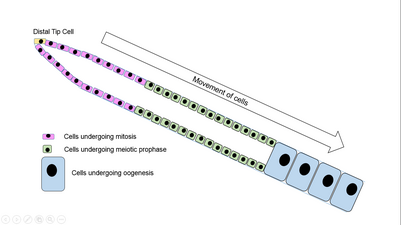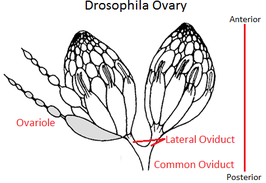Oogonial stem cells
Oogonial stem cells (OSCs), also known as egg precursor cells or female germline cells, are diploid germline cells with stem cell characteristics: the ability to renew and differentiate into other cell types, different from their tissue of origin.[1] Present in invertebrates and some lower vertebrate species, they have been extensively studied in Caenorhabditis elegans, Drosophila melanogaster. OSCs allow the production of new female reproductive cells (oocytes) by the process of oogenesis during an organism's reproductive life.[2][3]
Invertebrates[]
Caenorhabditis elegans[]

The nematode Caenorhabditis elegans (C. elegans) are nematodes can have hermaphroditic or male reproductive capabilities. In males, only spermatogenesis occurs; hermaphrodites can produce spermatozoa until adulthood, when oogenesis takes over.[4]
All oogonial stem cells in C. elegans are derived from one distal-tip cell (DTC), which acts as a niche to ensure that germline proliferation continues. As the DTC undergoes mitosis, the cells move proximally along the organism and passing from the mitotic-proliferative region into the meiotic cycle. During this cycle, the cells complete meiotic prophase before passing into the zone of oogenesis (or spermatogenesis, depending on the sex and age of the organism).[2][4][5]
D. melanogaster[]

Drosophila melanogaster (D. melanogaster), commonly known as the fruit fly, is a dioecious (two-sex) invertebrate. Female D. melanogasters have two ovaries, each of which have 16 ovarioles. The linear development from oogonial stem cells to mature oocyte is similar to that of C. elegans. In D. melanogaster, the 14-stage development of the oocyte is from the anterior to the posterior ovariole.[6] Mature oocytes are then stored in the uterus after passing through the oviduct, to wait for the egg deposition.
Vertebrates[]
In mammals, oogenesis is believed to be primarily prenatal. The existence of oogonial stem cells in mammals is controversial,[7] except for the finding of OSCs in two species of loris[8][9] and three species of bat.[10]
In 2004, considerable evidence was provided for the existence of germline stem cells in adult mouse ovaries capable of generating oocytes to form new follicles.[11][12][13] Questions exist about cell-sorting techniques used to isolate the OSCs,[14] and some researchers prefer the less-conclusive term "female germline stem cells" to "OSCs".[15] New research indicates that oogonial stem cells do not exist in mice and there is no convincing evidence they exist in other mammals.[16][17]
Research[]
A study published in 2015 reported that the formation of new oocytes from newly-discovered germline stem cells, known as oogonial stem cells, has opened new avenues for the treatment of female infertility.[18][19]
Research by Zuckerman et al. published in 1951, established a central dogma that neo-oogenesis in mammals does not occur postnatally.[20] These conclusions were supported by other researches, such as Peters et al., who investigated DNA synthesis in oocytes during embryonic development. However, since they didn’t study oogenesis postnatally, they could not make any conclusions about postnatal oogenesis.[21] In 1967, Loannou et al., studied proliferation of oogonia and sought to identify whether they were undergoing mitosis. They would be able to show this if there was observance of mitotic activity and whether or not they were contributing to stem cell populations. To do this, they used haematoxylin stains to stain for mitotic divisions. However, these results were inconclusive as they did not have oocyte markers and thus could not say for sure that these cells were a part of the stem cell population.[22] A number of scientists have since then used mathematical models to suggest that, without an oocyte stem cell (OSC) population, the female mammal will not have enough oocytes to complete their reproductive lives due to rate of atresia during the normal cycle is significant. However, in 2004, new research by Jonathan Tilly and colleagues came about to suggest that a new population of stem cells in female mammals does exist, which could possibly be used for personalized therapeutics. Using mouse studies, they were able to detect OSCs that were able to generate new eggs within these mouse ovaries. Tilly et al. used GFP to try to label the OSCs, but they didn’t know exactly where to find these stem cell populations, so it is difficult to say whether somatic cells or stem cells were labeled. This study challenged previously expected notions, as it contradicted the central dogma of oogenesis, and has thus led to a rapid increase in the amount of researching being conducted to suggest whether there does indeed exist oocyte stem cells in the mammalian ovary.[23] Lineage tracing and other studies, following initial observations in Tilly's lab, have found no supporting evidence for oogonial stem cells.[24] [25] [26]
References[]
- ^ "stem cell - definition of stem cell in English | Oxford Dictionaries". Oxford Dictionaries | English. Retrieved 2016-09-28.
- ^ a b Hubbard, E. Jane Albert (2007-12-01). "The C. elegans germ line: a model for stem cell biology". Developmental Dynamics. 236 (12): 3343–3357. doi:10.1002/dvdy.21335. ISSN 1058-8388. PMC 2949268. PMID 17948315.
- ^ Felici, Massimo De; Barrios, Florencia (2013-10-01). "Seeking the origin of female germline stem cells in the mammalian ovary". Reproduction. 146 (4): R125–R130. doi:10.1530/REP-13-0069. ISSN 1470-1626. PMID 23801781.
- ^ a b c Byrd, Dana T.; Kimble, Judith (2009-12-01). "Scratching the Niche That Controls C. elegans Germline Stem Cells". Seminars in Cell & Developmental Biology. 20 (9): 1107–13. doi:10.1016/j.semcdb.2009.09.005. ISSN 1084-9521. PMC 2820558. PMID 19765664.
- ^ Cinquin, Olivier; Crittenden, Sarah L.; Morgan, Dyan E.; Kimble, Judith (2010-02-02). "Progression from a stem cell–like state to early differentiation in the C. elegans germ line". Proceedings of the National Academy of Sciences of the United States of America. 107 (5): 2048–2053. Bibcode:2010PNAS..107.2048C. doi:10.1073/pnas.0912704107. ISSN 0027-8424. PMC 2836686. PMID 20080700.
- ^ White, R. A.; Perrimon, N.; Gehring, W. J. (1984-12-01). "Differentiation markers in the Drosophila ovary". Journal of Embryology and Experimental Morphology. 84: 275–286. ISSN 0022-0752. PMID 6442733.
- ^ Grieve, Kelsey M.; McLaughlin, Marie; Dunlop, Cheryl E.; Telfer, Evelyn E.; Anderson, Richard A. (2015). "The controversial existence and functional potential of oogonial stem cells". Maturitas. 82 (3): 278–281. doi:10.1016/j.maturitas.2015.07.017. PMID 26278874.
- ^ Duke, K. L. (1967-01-01). "Ovogenetic activity of the fetal-type in the ovary of the adult slow loris, Nycticebus coucang". Folia Primatologica; International Journal of Primatology. 7 (2): 150–154. doi:10.1159/000155114. ISSN 0015-5713. PMID 6069717.
- ^ David, G. F.; Anand Kumar, T. C.; Baker, T. G. (1974-12-01). "Uptake of tritiated thymidine by primordial germinal cells in the ovaries of the adult slender loris". Journal of Reproduction and Fertility. 41 (2): 447–451. doi:10.1530/jrf.0.0410447. ISSN 0022-4251. PMID 4476797.
- ^ Antonio-Rubio, Nivia Rocio; Porras-Gómez, Tania Janeth; Moreno-Mendoza, Norma (2013-01-01). "Identification of cortical germ cells in adult ovaries from three phyllostomid bats: Artibeus jamaicensis, Glossophaga soricina and Sturnira lilium". Reproduction, Fertility, and Development. 25 (5): 825–836. doi:10.1071/RD12126. ISSN 1031-3613. PMID 22953782.
- ^ Zou, Kang; Yuan, Zhe; Yang, Zhaojuan; Luo, Huacheng; Sun, Kejing; Zhou, Li; Xiang, Jie; Shi, Lingjun; Yu, Qingsheng (2009-05-01). "Production of offspring from a germline stem cell line derived from neonatal ovaries". Nature Cell Biology. 11 (5): 631–636. doi:10.1038/ncb1869. ISSN 1476-4679. PMID 19363485. S2CID 2172739.
- ^ Zhang, Yong; Yang, Zhaojuan; Yang, Yunze; Wang, Shuzeng; Shi, Lingjun; Xie, Wenhai; Sun, Kejing; Zou, Kang; Wang, Lei (2011-04-01). "Production of transgenic mice by random recombination of targeted genes in female germline stem cells". Journal of Molecular Cell Biology. 3 (2): 132–141. doi:10.1093/jmcb/mjq043. ISSN 1759-4685. PMID 21149239.
- ^ Oatley, Jon; Hunt, Patricia A. (2012-06-01). "Of Mice and (wo)Men: Purified Oogonial Stem Cells from Mouse and Human Ovaries". Biology of Reproduction. 86 (6): 196. doi:10.1095/biolreprod.112.100297. ISSN 0006-3363. PMC 6322432. PMID 22402962.
- ^ Woods, Dori C.; White, Yvonne A. R.; Tilly, Jonathan L. (2013-01-01). "Purification of Oogonial Stem Cells From Adult Mouse and Human Ovaries: An Assessment of the Literature and a View Toward the Future". Reproductive Sciences. 20 (1): 7–15. doi:10.1177/1933719112462632. ISSN 1933-7191. PMC 3676240. PMID 23024060.
- ^ Dunlop, Cheryl E.; Telfer, Evelyn E.; Anderson, Richard A. (2014-01-01). "Ovarian germline stem cells". Stem Cell Research & Therapy. 5 (4): 98. doi:10.1186/scrt487. ISSN 1757-6512. PMC 4282152. PMID 25157949.
- ^ Zhang, H; Panula, S; Petropoulos, S; Edsgärd, D; Busayavalasa, K; Liu, L; Li, X; Risal, S; Shen, Y; Shao, J; Liu, M; Li, S; Zhang, D; Zhang, X; Gerner, RR; Sheikhi, M; Damdimopoulou, P; Sandberg, R; Douagi, I; Gustafsson, JÅ; Liu, L; Lanner, F; Hovatta, O; Liu, K (2015). "Adult human and mouse ovaries lack DDX4-expressing functional oogonial stem cells". Nat Med. 21 (10): 1116–8. doi:10.1038/nm.3775. hdl:10616/44674. PMID 26444631. S2CID 2949653.
- ^ Lei, L; Spradling, AC (2013). "Female mice lack adult germ-line stem cells but sustain oogenesis using stable primordial follicles". Proc Natl Acad Sci U S A. 110 (21): 8585–90. Bibcode:2013PNAS..110.8585L. doi:10.1073/pnas.1306189110. PMC 3666718. PMID 23630252.
- ^ Garg, Neha; Sinclair, David A. (2015-07-29). "Oogonial stem cells as a model to study age-associated infertility in women". Reproduction, Fertility and Development. 27 (6): 969–974. doi:10.1071/RD14461. ISSN 1448-5990. PMC 4851909. PMID 25897831.
- ^ Garg, Neha; Sinclair, David A. (July 2015). "Oogonial stem cells as a model to study age-associated infertility in women". Reproduction, Fertility, and Development. 27 (6): 969–974. doi:10.1071/RD14461. ISSN 1031-3613. PMC 4851909. PMID 25897831.
- ^ Zuckerman, S (1951). "The number of oocytes in the mature ovary". Recent Progress in Hormone Research. 6: 63–108.
- ^ Peters, H; Levy, E; Crone, M (1962). "Deoxyribonucleic acid synthesis in oocytes of mouse embryos". Nature. 195 (4844): 915–916. Bibcode:1962Natur.195..915P. doi:10.1038/195915a0. PMID 14485731. S2CID 4207567.
- ^ Horan C H & Williams S A 2017 Oocyte stem cells: fact or fantasy? Reproduction Review 1470-1626
- ^ Tilly, J L; Telfer, EE (2009). "Purification of germ line stem cells from adult mammalian ovaries: a step closer towards control of the female biological clock?". Molecular Human Reproduction. 15 (7): 393–398. doi:10.1093/molehr/gap036. PMC 2696346. PMID 19509111.
- ^ Zhang, H; Panula, S; Petropoulos, S; Edsgärd, D; Busayavalasa, K; Liu, L; Li, X; Risal, S; Shen, Y; Shao, J; Liu, M; Li, S; Zhang, D; Zhang, X; Gerner, RR; Sheikhi, M; Damdimopoulou, P; Sandberg, R; Douagi, I; Gustafsson, JÅ; Liu, L; Lanner, F; Hovatta, O; Liu, K (Oct 2015). "Adult human and mouse ovaries lack DDX4-expressing functional oogonial stem cells". Nat. Med. 21 (10): 1116–8. doi:10.1038/nm.3775. hdl:10616/44674. PMID 26444631. S2CID 2949653.
- ^ Lei, L; Spradling, AC (May 2013). "Female mice lack adult germ-line stem cells but sustain oogenesis using stable primordial follicles". Proc Natl Acad Sci U S A. 110 (21): 8585–90. Bibcode:2013PNAS..110.8585L. doi:10.1073/pnas.1306189110. PMC 3666718. PMID 23630252.
- ^ Zarate-Garcia, L; Lane, SI; Merriman, JA; Jones, KT (Jun 2016). "FACS-sorted putative oogonial stem cells from the ovary are neither DDX4-positive nor germ cells". Sci. Rep. 6: 27991. Bibcode:2016NatSR...627991Z. doi:10.1038/srep27991. PMC 4908409. PMID 27301892.
- Stem cells